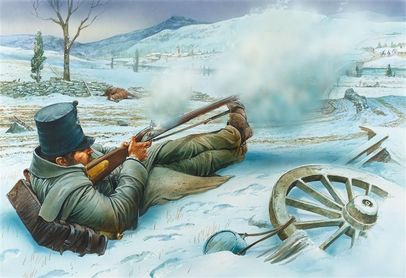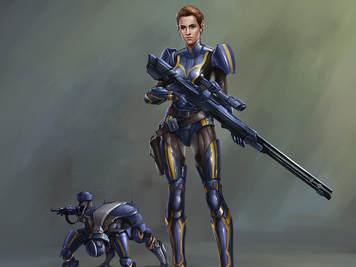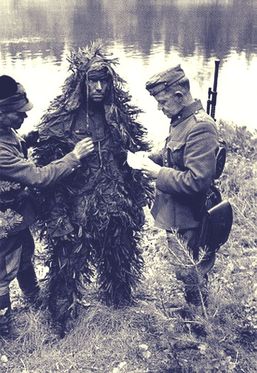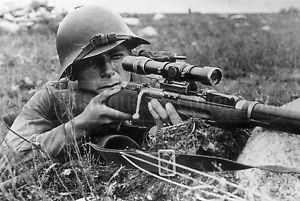Snipers have engaged the enemy throughout history and no doubt, pre-history. Ever since the earliest missile weapons were invented and used in warfare. In this article we are going to cover areas where they had a significant impact both on land and at sea (we all know the story of the death of Nelson at the Battle of Trafalgar).
Snipers in their modern form start from the use of hunting rifles during the American War of Independence, through the Colonial period and into the Boer and First World War. We have seen significant use of snipers since then and the art of concealment combined with advanced marksmanship principles and a variety of tactics throughout WW2 and into modern day. Will snipers evolve and be an important part of future wars.... there is little doubt with the advent of AIs and improved technology and indeed it could be said that drones could be the ideal 'Future Sniper'.
Snipers in their modern form start from the use of hunting rifles during the American War of Independence, through the Colonial period and into the Boer and First World War. We have seen significant use of snipers since then and the art of concealment combined with advanced marksmanship principles and a variety of tactics throughout WW2 and into modern day. Will snipers evolve and be an important part of future wars.... there is little doubt with the advent of AIs and improved technology and indeed it could be said that drones could be the ideal 'Future Sniper'.
|
Snipers, or more frequently sniper teams, should be portrayed at all levels of on-table wargaming either as specific units or abstractly. The major factors to recognise are:
|

Sniping in the Early 19th Century
A good example of how a sniper can affect the course of a battle was Private (later Corporal) Thomas Plunket who enlisted in the 95th Rifles of the British Army. Private Plunket gained note in Buenos Aires where he would shoot around 20 enemy from a sniping position on rooftops using his Baker rifle in 1807. However this was not his famous action... this was in the Spanish Peninsular at the Battle of Cacabelos in 1809.
Plunket rushed forward from the British positions & lay down on his back (to give him the best firing position - used also by Buffalo hunters in North America) in the snow and shot the French General de Brigade Colbert. Before returning to his own lines he also shot Colbert's aide-de-camp Latour-Maubourg, who had rushed to the aid of the fallen general. Plunket only just made it back to his own lines before being charged down by a dozen cavalry troopers, but the deaths of the two officers were sufficient to throw the pending French attack into disarray. Plunket was rewarded handsomely for his action.
A good example of how a sniper can affect the course of a battle was Private (later Corporal) Thomas Plunket who enlisted in the 95th Rifles of the British Army. Private Plunket gained note in Buenos Aires where he would shoot around 20 enemy from a sniping position on rooftops using his Baker rifle in 1807. However this was not his famous action... this was in the Spanish Peninsular at the Battle of Cacabelos in 1809.
Plunket rushed forward from the British positions & lay down on his back (to give him the best firing position - used also by Buffalo hunters in North America) in the snow and shot the French General de Brigade Colbert. Before returning to his own lines he also shot Colbert's aide-de-camp Latour-Maubourg, who had rushed to the aid of the fallen general. Plunket only just made it back to his own lines before being charged down by a dozen cavalry troopers, but the deaths of the two officers were sufficient to throw the pending French attack into disarray. Plunket was rewarded handsomely for his action.
The Development of the Modern Sniper
Telescopic sights were fitted to some British Army rifles during the Crimean War and as trench and siege warfare was prominent sniping techniques were developed, particularly by the British & French. In 1857 the first sniper rifle was developed in England, however it was not adopted by the British Army despite significantly outperforming the alternative. The Whitworth Rifle was however sold to both the French and teh Confederate Army during the American Civil War where it's first notable success was during the Battle of Spotsylvania Court House, where on 9 May 1864, Union General John Sedgewick was killed by a Confederate sharpshooter armed with a Whitworth at a range of about 1,000 yds/910m - famously just after saying the enemy "couldn't hit an elephant at this distance".
By the time of the 2nd Boer War sniper tactics (still better known as 'Sharpshooters') were well advanced and the first 'Ghillie' or sniper suits were worn by the famous Lovat Scouts.
By the Second World War sniper tactics were both proven and developed and by the end of the invasion of France in 1940 had achieved significant successes in delaying German advances. This coupled with Soviet successes during the Winter War meant that sniping was here to stay.
Telescopic sights were fitted to some British Army rifles during the Crimean War and as trench and siege warfare was prominent sniping techniques were developed, particularly by the British & French. In 1857 the first sniper rifle was developed in England, however it was not adopted by the British Army despite significantly outperforming the alternative. The Whitworth Rifle was however sold to both the French and teh Confederate Army during the American Civil War where it's first notable success was during the Battle of Spotsylvania Court House, where on 9 May 1864, Union General John Sedgewick was killed by a Confederate sharpshooter armed with a Whitworth at a range of about 1,000 yds/910m - famously just after saying the enemy "couldn't hit an elephant at this distance".
By the time of the 2nd Boer War sniper tactics (still better known as 'Sharpshooters') were well advanced and the first 'Ghillie' or sniper suits were worn by the famous Lovat Scouts.
By the Second World War sniper tactics were both proven and developed and by the end of the invasion of France in 1940 had achieved significant successes in delaying German advances. This coupled with Soviet successes during the Winter War meant that sniping was here to stay.



